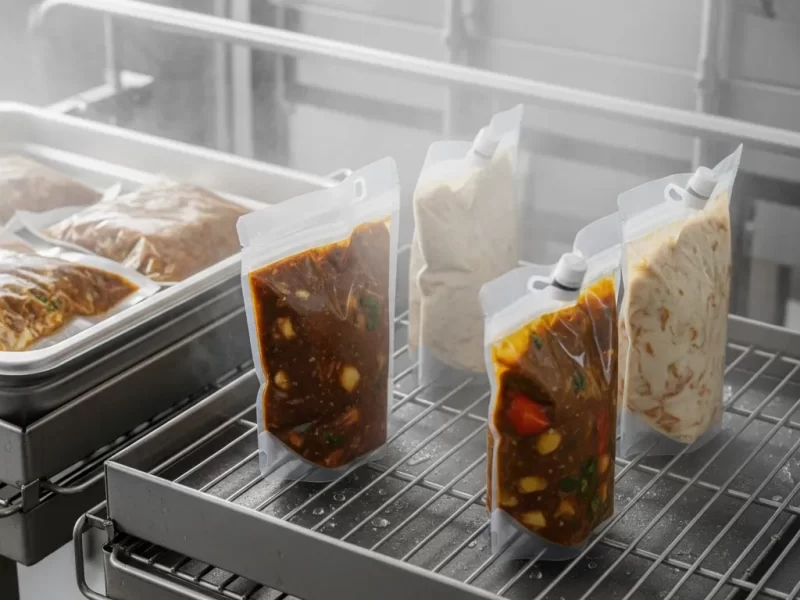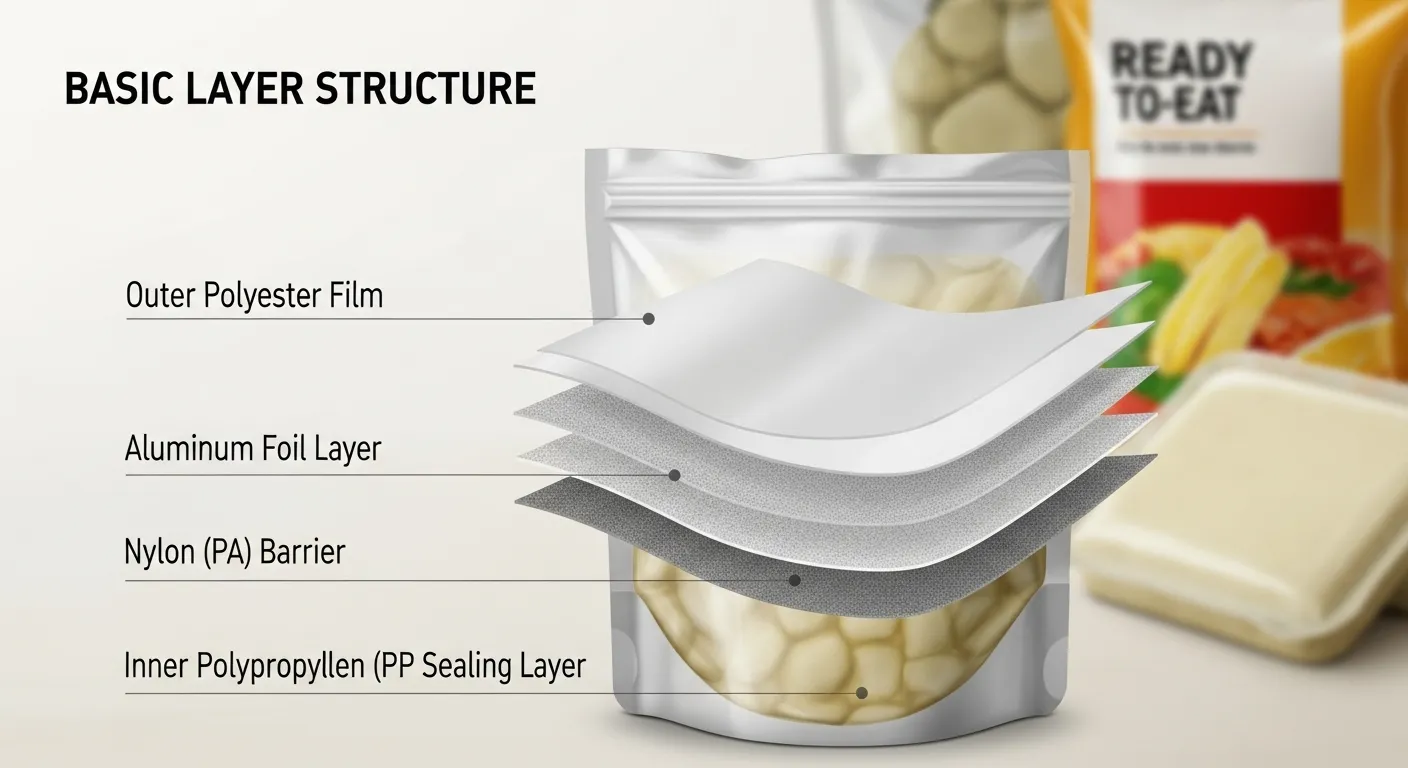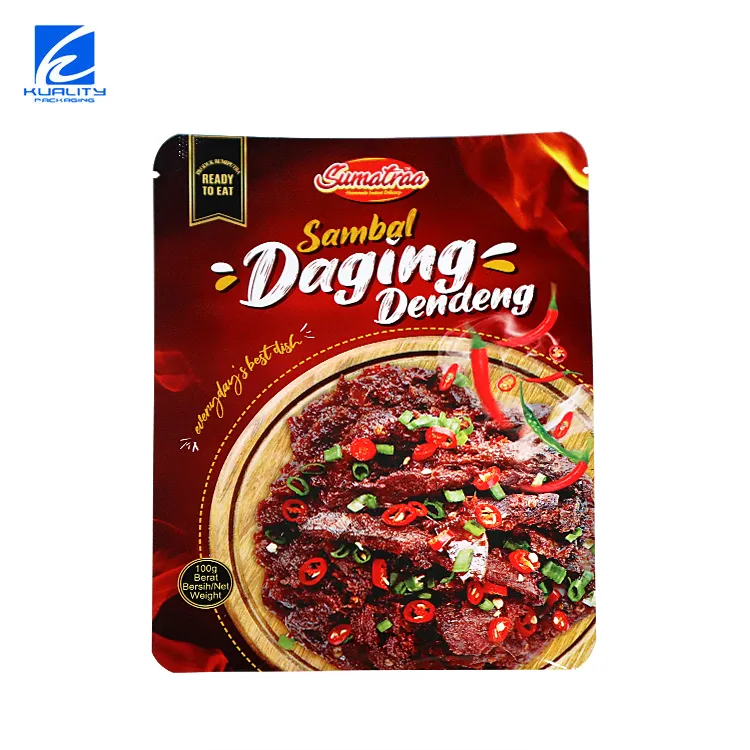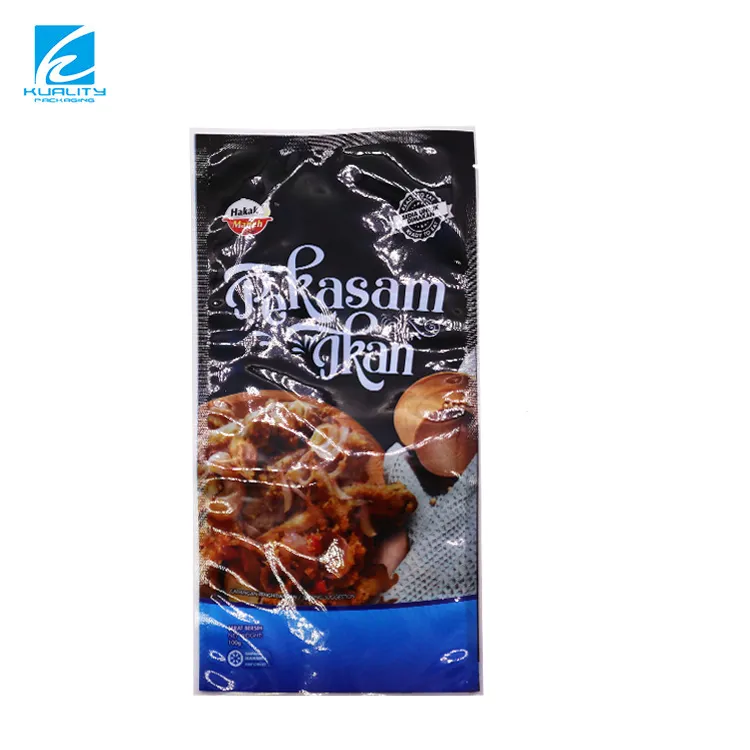
В компании Huiyang PackagingМы провели годы на передовой OEM-производства для международных брендов кормов для домашних животных, обрабатывая десятки тысяч Высокотемпературные ретортные пакеты ежедневно. Мы сталкиваемся с реальными проблемами: пакеты из алюминиевой фольги лопаются при стерилизации 121℃, а экологичные материалы отбраковываются и переделываются. Это не теории из учебников - это уроки, полученные на производстве. Как производитель ретортных пакетов на заказМы знаем, что выбор материала - это критический баланс между термостойкостью, экономичностью и безопасностью продукции. Наш опыт гарантирует, что вы всегда получите надежную, готовую к производству упаковку.
Адское испытание" высокотемпературных ретортных пакетов: Какие материалы выдерживают температуру 121℃?
Базовая четырехслойная структура (промышленный стандарт)

Когда вы откроете упаковку пакетика карри быстрого приготовления, вы увидите этот "стоптанный ногтевой поток":
Внешний слой: ПЭТ-пленка 12 мкм
- Функция: устойчивость к царапинам, проколам, логотип не выцветает.
- Секрет: Один бренд однажды перешел на БОПП, чтобы сэкономить, но после реторсии напечатанный рисунок превратился в абстрактную картину, и он потерял 800 000 юаней.
Вторичный слой: 15 мкм нейлон (PA)
- Функция: ударопрочность + предотвращение проникновения кислорода, эквивалент "связки" упаковки.
- Случай переворачивания: На одном из заводов OEM по ошибке использовался нерастянутый ПА, и после варки при температуре 121℃ степень усадки превысила 5%, а пакет превратился в квашеную капусту.
Сердечник: 7 мкм алюминиевая фольга
- Функция: блокирует кислород, свет и водяной пар, являясь спасительным ядром.
- Болевая точка: Количество отверстий в алюминиевом слое должно быть менее 3/㎡ (во время тестирования используются высоковольтные электрические искры, и при наличии отверстий излучается синий свет).
Внутренний слой: 70 мкм CPP (литой полипропилен)
- Назначение: прямой контакт с пищей, тепловая герметизация должна быть максимальной.
- История крови и слез: Партия CPP недостаточно термостойка, и после приготовления пакет пахнет пластиком. Затрат на отзыв хватит на покупку люкса.
Продвинутые игроки
- Без алюминиевой фольги: используют EVOH (сополимер этилена и винилового спирта) вместо алюминиевой фольги, и кислородопроницаемость составляет менее 3 куб. см/㎡ день. Японские низкотемпературные пакеты для приготовления пищи Nichirei используют этот трюк, но их стоимость на 40% дороже алюминиевой фольги.
- Эксклюзив для богатыхПленка из оксида кремния (SiOx) аэрокосмического класса, устойчивая к температуре 150°C и пригодная для микроволновой печи. Американский бренд Packit, выпускающий реторт-пакеты (высокотемпературные реторт-пакеты), выиграл военные заказы с этой пленкой, но цена за квадратный метр достаточна для покупки двух фунтов стейка.
2. Роковые детали: Линия жизни и смерти при разнице температур в 100°C для ретортных мешков
1. Предатель температуры: тепловая печать
Прочность уплотнения ≥50N/15мм - это красная линия в промышленности. Но здесь есть дьявольская деталь:
- Холодная печать VS тепловая печать:
Клей для холодной герметизации (например, Toyo-Lac от Toyo Can в Японии) сохраняет прочность >90% при температуре 135℃, но скорость производственной линии должна быть замедлена до 30%.
Традиционный термозапаивающий слой (CPP) имеет низкую стоимость, но он может расслаиваться, если разница температур немного велика. На одном литейном заводе партия изделий отслоилась и была отправлена в утиль из-за колебания давления пара на 2psi.
2. Невидимый убийца: остаточный растворитель
Остаток растворителя в печатной краске должен быть <5 мг/㎡ (национальный стандарт GB 9685). Бренд маринованных рыбных заготовок, продававшийся в Интернете, был отменен:
- В погоне за великолепной печатью толщина слоя краски превысила стандарт → растворитель испарился и расширился во время приготовления → в алюминиевой фольге появились микропоры → скорость расширения пакета составила 17% в течение срока годности;
- Послепродажных расходов хватит, чтобы построить новую производственную линию - кровавый убыток!
3. "Спрос", навязанный поколениями
- Микроволновая печь + прозрачность: внешний слой должен быть устойчивым к температуре 140℃ и прозрачным. Немецкая компания KHS выпустила четырехслойный прозрачный пакет для приготовления пищи из ПЭТ/ПА/ЭВОХ/ПП, но его кислородопроницаемость в 10 раз выше, чем у пакетов из алюминиевой фольги, и он может использоваться только в качестве продукта для короткой полки.
- Личность, защищающая окружающую среду: Один европейский бренд кормов для домашних животных использует бумажно-алюминиевые композитные пакеты и утверждает, что они подлежат переработке. Завод по переработке напрямую отказывается принимать бумагу + алюминий + пластик - эта волна "зеленой стирки" хорошо обыграна.
Breakout in 2025: Кто переписывает правила игры?
1. Политическая ядерная бомба: глобальное окружение из алюминиевой фольги
- С 2025 года ЕС введет экологический налог в размере 800 евро за тонну на композитную упаковку, содержащую алюминий.
- Японская ассоциация упаковки активно продвигает "план половинного использования алюминия": использование алюминизированного ПЭТ (VMPET) для замены части алюминиевой фольги, но при этом кислородозащитное свойство снижается на 30%, и срок годности вынужденно сокращается.
2. Революция материалов: Контратака нанопокрытий
- Керамическое покрытие: Покрытие AlOx (оксид алюминия) японской компании Otsuka Packaging, которое выдерживает температуру 150℃ и может быть обработано в микроволновой печи, используется в пакетах для детского питания;
- Графеновый армирующий слой: Китайский исследовательский институт выпустил пробные образцы с прочностью на прокол, увеличенной на 200%, но стоимость одной тонны достаточна для покупки BYD.
3. Технология черного цвета: от 8 часов до 8 минут
- Сверхвысокотемпературная мгновенная стерилизация (UHT): 135℃/3 секунды мгновенной стерилизации, с высокобарьерными алюминиевыми пакетами, срок хранения увеличивается с 18 месяцев до 6 месяцев, а уровень потери вкуса составляет менее 5% (традиционная потеря при пропаривании составляет 15%);
- Лазерное запечатывание: заменяет полоски термозапечатывания, точность ±0,1 мм, подходит для пакетов специальной формы (например, пакетов с автономным соплом), но инвестиций в оборудование достаточно, чтобы купить дом в небольшом городе.
Руководство по выживанию для производителей
- Низкий объемный тип: четырехслойный пакет из алюминиевой фольги + традиционный процесс отпаривания, ориентированный на рынок страны;
- Обновление среднего класса: ВМПЭТ заменяет алюминиевую фольгу 50% + стерилизация УВТ, ориентирована на супермаркеты городов первого и второго уровня;
- Высококлассный премиум-классПрозрачный пакет EVOH без алюминия + лазерная запечатка + этикетка "углеродный след", с чувством технологии, подчеркивая высококлассное ощущение продукта.
(Пожалуйста, сообщите нам ваше положение на рынке, размер и количество, и мы предоставим вам конкретное предложение)
Просматривайте промышленные изделия в пароварке
Когда вы берете в магазине пакет с карри быстрого приготовления, за разницей в цене упаковки стоит десятилетняя борьба материаловедов, политиков и бухгалтеров. В следующий раз, когда вы откроете пакет, подумайте: сколько степеней жизни и смерти пережила эта пленка, прежде чем благополучно доставить ваше блюдо в рот.
Взаимодействие: Если вы знаете, что экологически чистая упаковка увеличит цены на продукты питания на 30%, но при этом будет загрязнять на 3 квадратных метра земли меньше в месяц, готовы ли вы за нее платить? Оставьте сообщение в комментариях!


